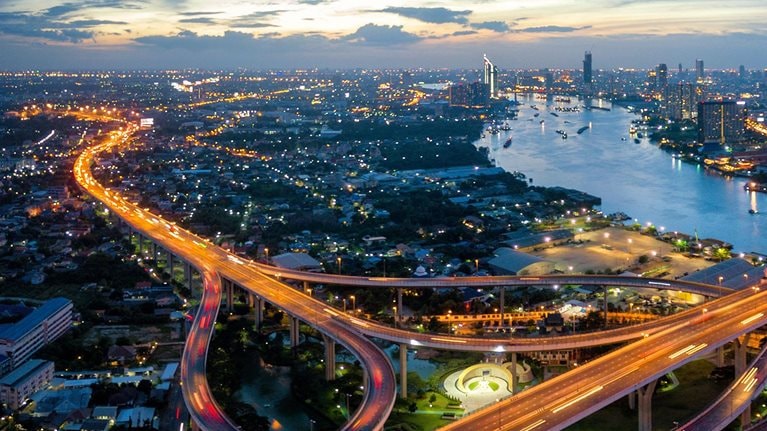Momentum for sustainable infrastructure has increased significantly in recent years, but creating a pipeline of bankable, investment-ready projects remains a significant hurdle. The Global Infrastructure Hub (GI Hub), a nonprofit organization formed by the G-20, works across the public and private sectors to help advance the development of sustainable infrastructure—defined for the purposes of this article as all infrastructure needed to achieve the UN Sustainable Development Goals.
McKinsey recently spoke with Marie Lam-Frendo, CEO of the GI Hub, to discuss what can be done to develop partnerships, derisk projects and leverage public spending to attain private investment, meet local infrastructure demands, and achieve sustainable-infrastructure goals.
McKinsey: In terms of scaling sustainable infrastructure, what were the most relevant trends in financing and investing in 2022, and where do you hope to see improvement in 2023?
Marie Lam-Frendo: As the magnitude of the climate crisis came into sharper focus in 2022, so did the emphasis on financing and investing to scale sustainable infrastructure. I expect these areas to retain relevance in 2023 as well.
This shift was apparent at COP27 [the 2022 UN Climate Change Conference] and among the G-20. The actions of the NGFS [Network of Central Banks and Supervisors for Greening the Financial System] and the ISSB [International Sustainability Standards Board] were used as examples for implementing targeted policy reforms and standards development to streamline sustainable finance. There have also been substantial efforts to scale up blended finance, particularly through the development of country-specific programs like the Just Energy Transition Partnerships. These programs help develop sustainable-finance solutions that can be replicated in other jurisdictions. Although still at an early stage, both mechanisms can help infrastructure players derisk and scale up investments and gain more systematic support from private-sector investors.
Private-capital mobilization has been a priority for the G-20. The private sector is similarly looking for more efficient ways to deploy the substantial amount of money that has built up over the past decade or so of underinvestment. The multilateral system can help enable and shape infrastructure financing and investment for 2023, particularly by derisking investments. The recent review of multilateral development banks’ [MDBs’] capital adequacy frameworks emphasized the need for MDBs to mobilize more private-sector investment. The G-20 Finance Track helped with this work, which, to me, is an example of the role that a group like the G-20 can have in driving much-needed change.
Our multilateral institutions and the global financial architecture must adapt, however, to meet the urgent need for sustainable development during the climate transition while navigating the current complex economic and geopolitical environment. Some prospective financing and investment solutions can be massively grown and given incentives through international or multilateral efforts, and we need to take this opportunity.
Over the past 12 years, the G-20 has worked on infrastructure and has put out 90 recommendations, but few have been implemented. Rather than putting all our energy toward finding a gold-plated system that will solve every problem and advance every solution at the same time, we can start with specific, feasible actions and implement them in collaboration. It is difficult to align 20 countries on specific commitments that might run counter to their agendas domestically or internationally, but we must find ways to move forward to contend with the time pressure imposed by the climate crisis.
Would you like to learn more about our Global Infrastructure Initiative?
McKinsey: You mentioned a renewed momentum behind collaboration despite the complex geopolitical environment. What are some of the values that make these collaborations work?
Marie Lam-Frendo: To negotiate well, you need to understand what the other side wants, and to do that, you also need to approach the partnership with humility to show that no one is more important than anyone else, and everyone must participate equally to make the project happen. The hesitations we’ve seen around public–private partnerships [PPPs] in recent years are a result of the erosion of trust between the public and private sectors in both developed and developing economies.
For these reasons, it’s especially important to show a bit of vulnerability in a partnership to remember why you’re all working together. Infrastructure investment is not a ribbon-cutting exercise; the objective should be to ensure that our people and communities have better access to services that will allow them to contribute to the economy and, more generally, to have societal well-being and greater equity—like our kids being able to get to school faster, or our parents being able to get to medical appointments on their own and maintain mobility late into their lives. Each partner should recognize that they’re not doing a project for themselves; they’re serving a bigger purpose. Ultimately, we’re here to serve our community wherever we sit—on the government side, the engineering side, the financing side, or the legal side.
McKinsey: What types of risk-mitigating measures can encourage or derisk channeling funds into emerging-market infrastructure?
Marie Lam-Frendo: Not many countries have attained a triple-A rating, and this includes OECD countries. If a country is below that level, attracting investors is more complicated. At the same time, we are also at a tipping point with the banks. Our flagship Infrastructure Monitor report has shown that banks are pulling back from infrastructure because of the implementation of the Basel III reforms, which will have a tremendous impact on banks’ ability to continue lending. But if banks stop lending, emerging economies that do not have deep or strong local capital markets will have a hard time sourcing debt, limiting the ability to invest in infrastructure. More recently, rising inflation has also made debt less available and more expensive.
In terms of risk mitigation, the risk span of infrastructure is quite broad. It’s important to realize that there are different types of risks: there is risk within the transaction, and there is risk in the enabling environment. This year, the GI Hub is working to map the coverage and role of the many risk mitigation instruments that exist in MDBs and similar institutions. It’s important to understand the landscape and what is available in emerging versus developed economies. In some economies, for example, there are risks that can be allocated from the government to the private sector, but not everything can be shifted there. To help bring clarity to this area, we are putting together a repository that catalogs what funding is available and where for specific-sized projects, in addition to the volume of funding used on risk mitigation to date.
Among G-20 economies in 2019, only 38 percent had a national infrastructure plan. That type of plan is important for a country’s long-term strategy, and it also provides some reassurance to investors that there is a pipeline of investments coming. An initiative we’re working on in collaboration with the G-20 to help develop these strategies is GI Hub’s InfraTracker, which will help governments create these plans and pipelines for investment by tracking public investment in infrastructure.
McKinsey: What innovations do you see for the infrastructure sector in the future?
Marie Lam-Frendo: There is growing momentum around embedding technology into infrastructure. Investing in infratech would help the infrastructure sector work faster and cheaper with better outcomes. We have yet to learn how to finance these investments at scale and include them with other technologies that are supported by venture capital investors. Blended finance can help scale this up and derisk the technology, and the GI Hub is working on this topic.
The private sector has been a strong advocate of the innovations and benefits infratech could bring. While some of these technologies are not too expensive, we need to ensure that whatever is built today is future-proof; we expect those assets to serve us in 50 years’ time. We also need to think about infrastructure not only as a path to economic growth or job productivity but also as a way to achieve net-zero targets. Employing the right technology is critical to hitting those targets. We shouldn’t limit our thinking about innovation to any one sector or technology, but rather embrace collaboration among governments, investors, and tech creators to scale these solutions and put them on the market quickly.
This article is part of Global Infrastructure Initiative’s Voices on Infrastructure.

